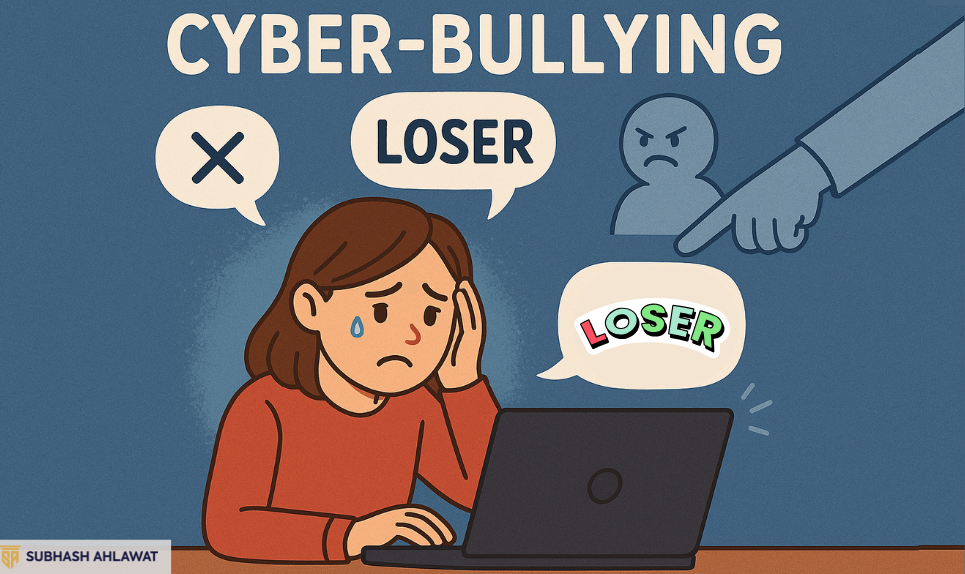What Is Cyber-Bullying? Your Legal Rights in India

What Is Cyber-Bullying?
Cyber-bullying means any repeated, intentional act online that shames, scares, or harms another person. It can be:
Mean messages, name-calling, threats, or slurs in posts, comments, or DMs
Posting lies or private photos to ruin a person’s image
Pretending to be someone else to deception, cheat, or cause humiliation.
Sharing phone numbers, addresses (“doxxing”), or other private facts
Because the bully hides behind a phone or laptop, victims often feel helpless. Indian law says you do not have to stay silent.
Why Cyber-Bullying Hurts More Than a Joke
Words on a screen can follow you everywhere—home, school, work. They stay online, get shared fast, and reach strangers who pile on. The result can be anxiety, loss of sleep, and in severe cases self-harm. Lawmakers and courts treat these harms as real, not “just online.”
Legal Shields
1. The Information Technology (IT) Act 2000
Section | What It Covers | Punishment* |
66C | Identity theft—using your photo, ID or password | Up to 3 years jail + fine ₹1 lakh |
66D | Impersonation/online cheating | Up to 3 years + fine ₹1 lakh |
67 | Publishing obscene material | Up to 3 years + fine ₹5 lakh (first time) |
*Section 67- Penalties become more severe for repeat offenses, with punishments including imprisonment for a maximum of five years and fines reaching up to ten lakh rupees.
Note on Section 66A: Police once used it to arrest people for “annoying” posts, but the Supreme Court struck it down in Shreya Singhal v. Union of India (2015). If anyone quotes 66A against you today, remind them it is dead law.
2. Bharatiya Nyaya Sanhita (BNS) 2023
The BNS is India’s modern criminal code, replacing parts of the old IPC. Key parts for cyber-bullying:
Sec 351 – Criminal Intimidation: Threats of harm.
Sec 356 – Defamation: Spreading lies that damage reputation.
Sec 74 & 75 – Outraging modesty / Sexual harassment: Covers lewd photos or sextortion.
Sec 196 – Promoting enmity: Hate speech that targets caste, religion, gender, etc.
Penalties range from fines to three years in jail (more if threats involve serious violence).
3. Special IPC Provisions (still active)
Sec 354D – Cyber-stalking: Following or contacting someone online against their will. Up to 3 years jail (first offence).
Sec 499/500 – Criminal Defamation: Lies that ruin reputation.
Sec 507 – Anonymous threats: The statute covers menacing communications transmitted while concealing the sender's identity.
Sec 509 – Insulting a woman’s modesty: Words or gestures that humiliate.
4. Child-Focused Shields
POCSO 2012: Any sexual content aimed at a minor is a grave offence.
Juvenile Justice Act 2015: If the bully is under 18, the act guides reform and punishment.
5. Digital Personal Data Protection (DPDP) Act 2023
Leaking private data can bring steep fines on the bully or the platform.
6. Digital India Act (Coming)
A draft tabled in 2025 will add explicit crimes for doxxing, deepfakes, and cyber-bullying, promising clearer, faster remedies.
Your Rights Under These Laws
Right to Complain
Any cyber-bullying incident can be reported:
The service is accessible online via the National Cyber Crime Reporting Portal at cybercrime.gov.in.
Phone call 1930 (24×7 helpline). States now promise a call-back within five minutes.
The local Police Station asked to file an FIR. You may bring a friend or lawyer with you.
Remember the four golden steps: collect proof, complain fast, cite the right section, and follow up. With these steps—and help from professionals like Advocate Subhash Ahlawat —the screen that once felt scary can feel safe again.
Right to Safe Removal
You can ask social-media platforms to delete harmful posts. Under IT Rules 2021, they must act in 24 hours for nude, morphed, or child content. If they ignore you, you can escalate to the platform’s Grievance Officer, then to the government’s Grievance Appellate Committee online.
Right to Privacy
If someone leaks your phone number or address, Sections 66E (privacy breach) of the IT Act and DPDP 2023 let you demand takedown and damages.
Step-by-Step: How to Use Your Shield
Save Proof – Take screenshots with date and URL. Copy chat logs.
Block and Report inside the app. It stops fresh abuse and shows the police you acted.
File a Portal Complaint – Upload proofs. You get an acknowledgment number.
Visit Police (if needed) – Give copies. Ask for Sec 66C/66D/354D, etc., as they fit.
Ask for Content Takedown – Send a simple email to the platform's grievance address.
Follow Up – Keep diary notes of each step, date, and officer name.
Courts accept portal complaint numbers as equal to an FIR in many states, speeding up refunds and arrests.
How Police and Courts Handle the Case
Preliminary inquiry – Cyber-cell checks IP logs, SIM details.
Notice to Platform – Seeks user data from Instagram, X, Snapchat, etc.
Seizure of Devices – If accused is found.
Charge-sheet – Police list sections (e.g., 66C + 507).
Trial – Sessions court or special POCSO court if a child is involved.
Relief – The court may issue restraining orders, award compensation, or impose imprisonment. Conviction timelines have significantly reduced due to the availability of clear digital evidence, including screenshots and server logs.
Tips to Stay Safe and Strong
Limit public info – Keep profiles private, hide phone and email.
Use Two-Step Login to stop account takeovers (identity theft).
Think Before Posting – Once online, it spreads fast.
Talk Early – If a child, tell a trusted adult at the first sign.
Seek Counseling – Cyber-bullying can hurt mental health; talking helps.
Know Your Helplines – 1930 (cyber fraud), 1098 (child), 1091 (women).
The Road Ahead
India’s laws used to treat online abuse as side-issues inside bigger offences. That patchwork left gaps. New codes (BNS 2023) and the coming Digital India Act aim to plug those gaps, making “cyber-bullying” a stand-alone crime with clearer police powers and stricter fines.
At the same time, platforms face rising duties: faster takedowns, traceability of originators, and yearly safety audits. Victims will no longer chase ten different sections. A single, strong clause will soon cover doxxing, deepfake misuse, revenge porn, and hateful trolling in one go.
Conclusion
Cyber-bullying is not a harmless prank. Indian law treats it as a crime, and you have many shields—Sections 66C/D, 67, 354D, BNS provisions, child laws, data laws, and new rules on the way.
Remember four golden steps: collect proof, complain fast, cite the right section, and follow up. By following these steps, the screen that once seemed intimidating can become safe again.


